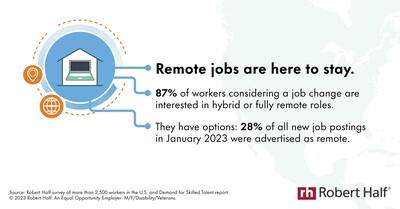The State of Remote Work: 5 Trends to Know for 2023
Research from Robert Half reveals that remote jobs are here to stay, with 87% of workers considering job changes interested in hybrid or fully remote roles. In January 2023, 28% of new job postings were remote, equal to the previous year. Work flexibility enhances job satisfaction, with 46% of workers reporting increased happiness despite longer hours. Notably, 32% are willing to accept pay cuts averaging 18% for full remote work. However, 65% value in-person relationships with colleagues, while 82% of managers believe all workers have equal career advancement opportunities. The surveys included over 4,600 U.S. workers and managers.
- 87% of workers considering job changes interested in hybrid or remote positions.
- 28% of new job postings in January 2023 were remote, indicating stable demand.
- 77% of professionals report higher job satisfaction from flexible work arrangements.
- 32% of workers willing to accept a salary reduction averaging 18% for full remote work.
- 82% of managers believe remote and in-office employees have equal advancement opportunities.
- 42% of remote workers are concerned about visibility for promotions.
- Only 49% feel comfortable collaborating in person compared to 31% virtually.
Insights
Analyzing...
- Remote jobs are here to stay. Professionals remain confident in the job market, and having greater flexibility to choose where and when to work is a top motivator for making a move. Nearly 9 in 10 workers considering a job change (
87% ) are interested in hybrid or fully remote positions. And they have options:28% of all new job postings inJanuary 2023 were advertised as remote, on par with29% a year ago.* ViewRobert Half's Demand for Skilled Talent report for insight on roles with the greatest percentage of remote opportunities. - Work flexibility can lead to greater happiness. More than three-quarters of professionals (
77% ) who can work where and when they are most productive are putting in more hours now than three years ago. Despite longer workdays,46% report higher job satisfaction. - Some would sacrifice salary for more remote time. Nearly one-third of workers (
32% ) who go into the office at least one day a week are willing to take a pay cut for the ability to do their job remotely all the time. When asked by how much, the average response was18% . Technology professionals (47% ), 18- to 25-year-olds (42% ) and working parents (41% ) are most likely to accept a salary reduction to be fully remote. - Being in the office has benefits. Nearly two-thirds of professionals (
65% ) said they have more effective relationships with colleagues they've met face-to-face versus those they have not. And more workers are comfortable collaborating in person (49% ) than virtually (31% ). Read about the benefits of working "in person with a purpose" inRobert Half's Your Future Is Flexible report. - Employees have career opportunities, wherever they are. Most managers (
82% ) who oversee hybrid teams feel in-office and remote employees have the same opportunities for career advancement. Yet,42% of remote workers are concerned about being visible for project opportunities and promotions. Managers said the best ways for off-site employees to position themselves for growth are: - Having regular career pathing conversations
- Expressing interest in professional development opportunities
- Volunteering to lead or contribute to projects
"Even though we've seen more people return to the office as of late, companies shouldn't pull back on remote work policies," said
The online surveys were developed by
*
![]() View original content to download multimedia:https://www.prnewswire.com/news-releases/the-state-of-remote-work-5-trends-to-know-for-2023-301751351.html
View original content to download multimedia:https://www.prnewswire.com/news-releases/the-state-of-remote-work-5-trends-to-know-for-2023-301751351.html
SOURCE









